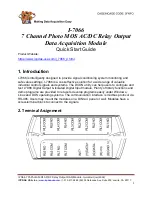
Page 10
2002 Eventide Inc.
Manual Version 1.0
3
2
1
The Back Panel
1)
ANALOG IN
Connect the analog outputs of a mixer, a compressor, or some other such
device to these XLR inputs. Pin 1 is ground, pin 2 is positive phase (hot), and
pin 3 is negative phase (cold). To “unbalance” the XLR jack, use both pins 1
and 3 as ground and use pin 2 as “hot.”
If either pins 1 or 3 are unconnected, you will
get more noise and hum than signal!
The holes in the middle look like 1/4-inch
inputs, but they are not, so don't attempt to use them. Professionals prefer
XLRs.
2)
ANALOG OUT
These analog outputs accept balanced XLR connectors. The same pin layout
and “ungrounding” procedure described above apply here as well.
3)
RELAY IN
A two-pole relay is activated while the
DELETE
LED is illuminated. Use this
function to control other devices. During DELETE, it connects pin 2 of this
connector to pin 2 of “Relay Out.” At the same time, it separately connects pin 3 of this
connector to pin 3 of “Relay Out.”
4)
RELAY OUT
As described under "Relay In" above.
5)
RS232 SERIAL PORT
Use this port for software updates or for simple remote control. See
Remote Control
Options
on page 13 for more information. In the event of software updates being made
available, they will be supplied with instructions for their use.
6)
SWITCH 1/2
Use this 1/4-inch tip-ring-sleeve connector for remote control. Contact closure between the
ring and sleeve puts the BD960 in
BYPASS
. Contact closure between the tip and sleeve
triggers
DELETE
(use a remote controller that will only close the tip-sleeve circuit
momentarily,
so that the circuit will be "ready" to be triggered every time – typically this is a simple push-
button).
7)
SWITCH 3/4
This input is reserved for future use.
8)
AC PORT
Connect an IEC standard 3-prong AC power cord here. The center post is chassis ground.
3
2
1
100-240VAC 50-60Hz 45W
SWITCH 3/4
SWITCH 1/2
SERIAL
RELAY
SWITCH 3/4
SWITCH 1/2
OUT
SERIAL
ANALOG IN
ANALOG OUT
IN
CH2
CH1
CH2
CH1



































